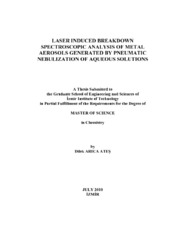Please use this identifier to cite or link to this item:
https://hdl.handle.net/11147/3051Full metadata record
| DC Field | Value | Language |
|---|---|---|
| dc.contributor.advisor | Yalçın, Şerife | - |
| dc.contributor.author | Ateş Arıca, Dilek | - |
| dc.date.accessioned | 2014-07-22T13:50:48Z | - |
| dc.date.available | 2014-07-22T13:50:48Z | - |
| dc.date.issued | 2010 | - |
| dc.identifier.uri | http://hdl.handle.net/11147/3051 | - |
| dc.description | Thesis (Master)--İzmir Institute of Technology, Chemistry, İzmir, 2010 | en_US |
| dc.description | Includes bibliographical references (leaves: 53-55) | en_US |
| dc.description | Text in English; Abstract: Turkish and English | en_US |
| dc.description | x, 55 leaves | en_US |
| dc.description.abstract | Laser Induced Breakdown Spectroscopy, LIBS, is an analytical technique used to determine the elemental composition of samples in all forms. In this study, an experimental LIBS system has been designed and constructed for the analysis of metal aerosol particles that are generated by a pneumatic nebulizer. This research provides a basis and preliminary data for the construction of a portable LIBS system to analyze metals in aqueous environments.The aerosol particles generated from the pneumatic nebulizer travel through a sample introduction unit to reach the sample cell in which they interact with the laser beam. The source of light is a Nd:YAG laser at 532 nm, 10 Hz. When the laser beam is focused inside the sample cell, plasma is generated, and the emission containing the spectral information about the sample being analyzed is focused onto the spectrograph and detected by a gated detector. The optimum optical and experimental parameters were systematically investigated.The aqueous analyte solutions were prepared from their salts before introduced into the system. In this work, laser-induced breakdown spectroscopic emissions of Na, Ca, Mg and K aerosols were studied. In single shot mode, the minimum detectable aqueous concentrations were found as 250 ppb, 500 ppb, 400 ppb and 10 mg/L respectively. For 10 shot accumulated analyses in repetitive mode, based on 3. criterion, the detection limit (LOD) was determined as 1 mg/L, 0.6 mg/L, 1.5 mg/L and 16.3 mg/L respectively. The efficiency of the drying unit has been evaluated by particle size measurements. It has been shown that the Na aerosols with particle size of 4.3 .m decreases to 0.5 .m after passing through the membrane dryer unit. | en_US |
| dc.language.iso | en | en_US |
| dc.publisher | Izmir Institute of Technology | en_US |
| dc.rights | info:eu-repo/semantics/openAccess | en_US |
| dc.subject.lcsh | Aerosols--Analysis | en |
| dc.subject.lcsh | Laser-induced breakdown spectroscopy | en |
| dc.subject.lcsh | Solution (Chemistry) | en |
| dc.title | Laser Induced Breakdown Spectroscopic Analysis of Metal Aerosols Generated by Pneumatic Nebuliztion of Aqueous Solutions | en_US |
| dc.type | Master Thesis | en_US |
| dc.institutionauthor | Ateş Arıca, Dilek | - |
| dc.department | Thesis (Master)--İzmir Institute of Technology, Chemistry | en_US |
| dc.relation.publicationcategory | Tez | en_US |
| dc.identifier.wosquality | N/A | - |
| dc.identifier.scopusquality | N/A | - |
| item.openairecristype | http://purl.org/coar/resource_type/c_18cf | - |
| item.languageiso639-1 | en | - |
| item.openairetype | Master Thesis | - |
| item.grantfulltext | open | - |
| item.fulltext | With Fulltext | - |
| item.cerifentitytype | Publications | - |
| Appears in Collections: | Master Degree / Yüksek Lisans Tezleri | |
Files in This Item:
| File | Description | Size | Format | |
|---|---|---|---|---|
| T000206.pdf | MasterThesis | 1.04 MB | Adobe PDF |  View/Open |
CORE Recommender
Page view(s)
234
checked on Mar 31, 2025
Download(s)
106
checked on Mar 31, 2025
Google ScholarTM
Check
Items in GCRIS Repository are protected by copyright, with all rights reserved, unless otherwise indicated.